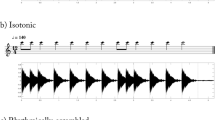Summary
In conditions of free movement of animals (3 experimental dogs), it was impossible to achieve stable differentiation of the metronome frequencies-120 and 60 beats per minute-on the basis of the excitation process concentration. To elaborate stable differentiation in the given experimental conditions, the nervous process provoking differentiation of conditioned stimuli should be formed in the latent period of conditioned reaction.
Similar content being viewed by others
Literature Cited
Emchenko, A. I., In the book: “Contemporary problems of the physiology of the nervous and muscle systems” [in Russian] Tbilitsi (1956) p. 311.
Konradi, G. P., Trudy Fiziologicheskoy Laboratorii Im Pavlova,4, 1–2, 60 (1932).
Kupalov, P. S., Klin. Med., 12, 3–4 (1946).
Kupalov, P. S., “The collection of works devoted to the 60 years of the life of the Academician A. D. Spreanskii”, [in Russian] Moscow (1950) p. 163.
Leporskii, N. I., Dissertation: Material on the physiology of conditioned inhibition. (Spb., 1911).
Tolmasskaya, E. S., In the book: “Problems of higher nervous activity” [in Russian] (Moscow, 1949) p. 351.
Khananashvili, M. M., “The differentiation of positive conditioning stimuli, being reinforced by homogeneous stimuli (feeding, unconditioned reflexes).
Author information
Authors and Affiliations
Rights and permissions
About this article
Cite this article
Syrensky, V.I. Differentiation of sound rhythmic stimuli during free movement of the animal. Bull Exp Biol Med 51, 404–407 (1961). https://doi.org/10.1007/BF00779522
Received:
Issue Date:
DOI: https://doi.org/10.1007/BF00779522




